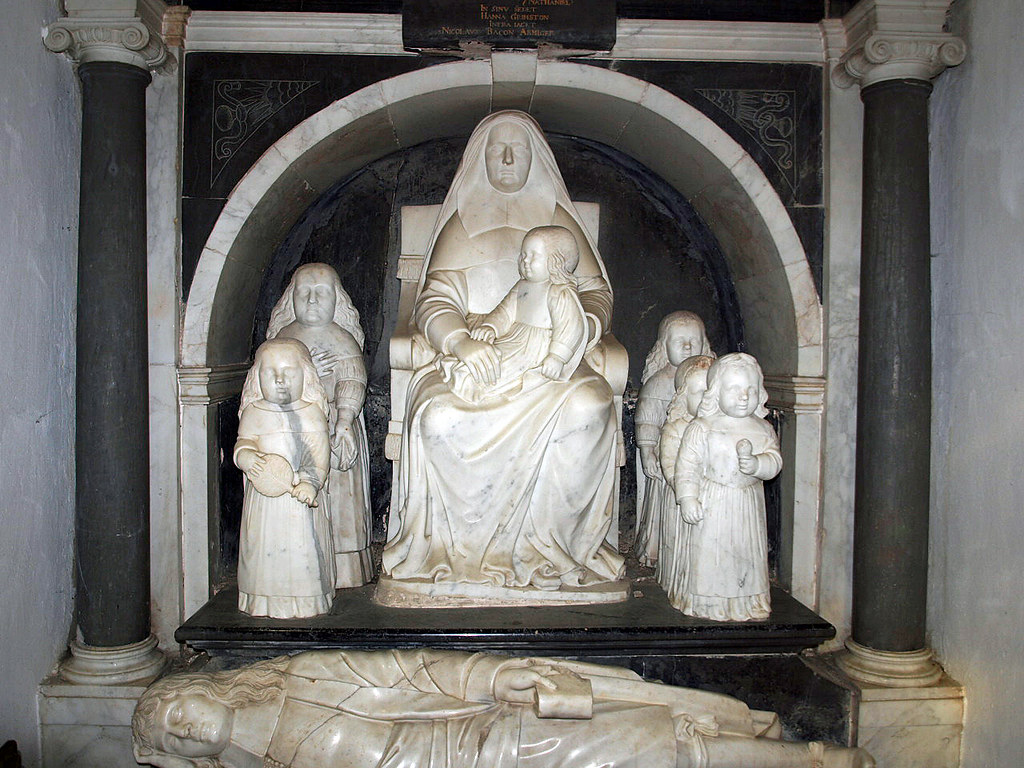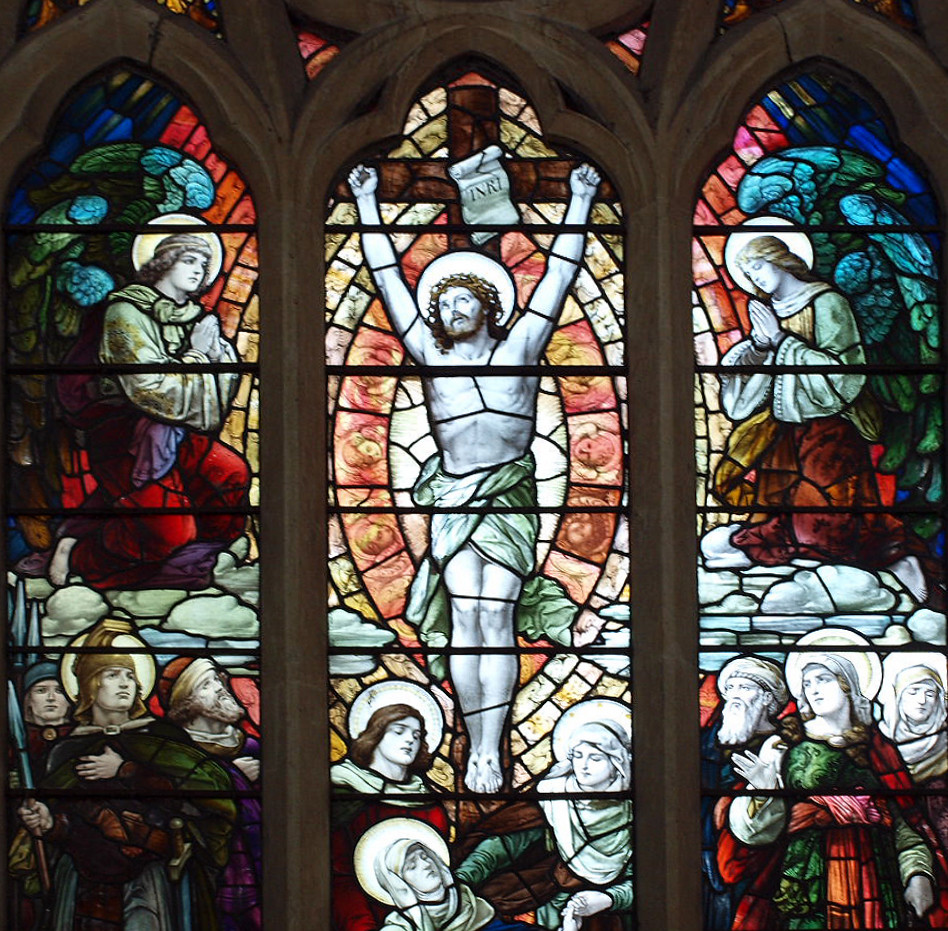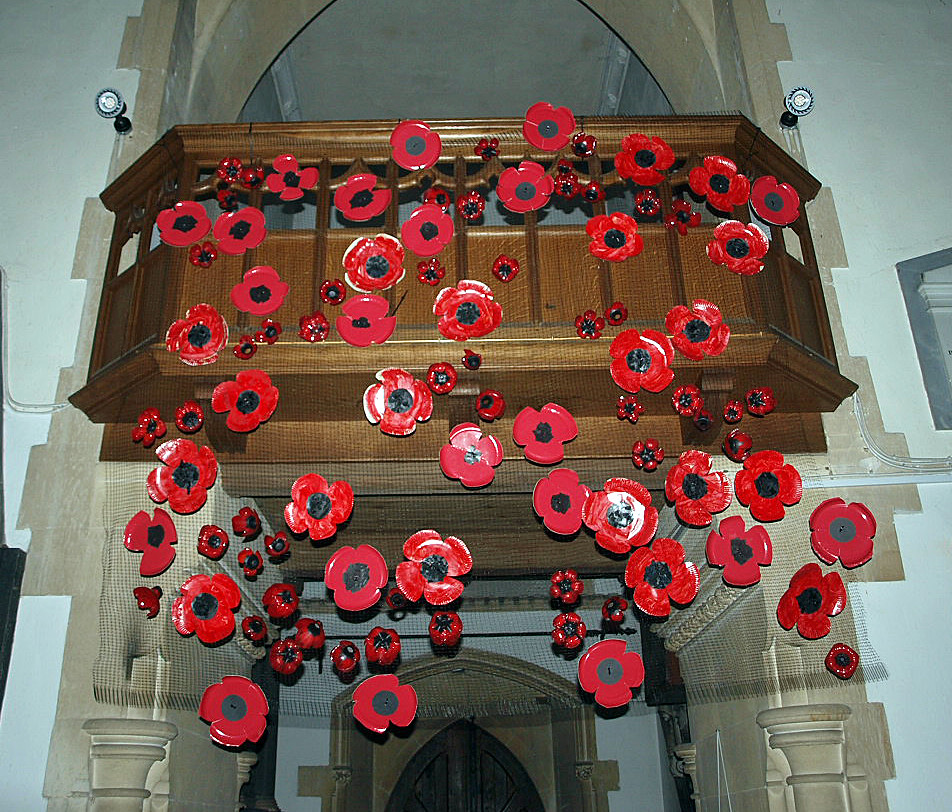ST MARY.* In the grounds of the house. Rebuilt in 1856-65 by Blomfield. N aisle of 1908. The tower partly medieval. - MONUMENTS. Jane Bacon, 1654 by Thomas Stanton, who was paid £300 to do it ‘alle in whit and black marble without the addition of any other stone whatsoever’. Grey marble with white marble figures. A large standing wall-monument. Her husband lies below on his side and elbow. Above, between Ionic columns, mother and children. She is seated frontally and holds a small child in her lap. Five more kneeling frontally to her l. and r. one behind another: a sincere, not at all aristocratic, rather Dutch group. Open segmental pediment. - Sir Nathaniel Bacon, the amateur painter, d. 1627. Lozenge-shaped tablet with, in the middle, an oval recess with portrait bust. Garlands l. and r. and also two palettes. - Second Marquess Cornwallis d. 1823. By E. H. Baily. White urn before a black obelisk; nothing special. - Beatrix Jane Craven, Countess Cadogan, d. 1907. By Countess Feodora Gleichen.** Recumbent effigy of white marble in a vaulted recess. On the back wall putti, a cross, and large vine-trails.
* The dedication is given as St Michael in a will of 1535 (ARA).
** I am indebted to Earl Cadogan for this information.
CULFORD. With memories of great names and great days, it lies in beautiful country, through which the little River Lark sings its quiet song. Its richest treasures are bounded by a 500-acre park in which stand the church, the fine old rectory, and the majestic hall surrounded by gardens in which many cherished varieties of flowers have been skilfully evolved.
The first hall was built by Sir Nicholas Bacon, stepbrother of the great Francis, and was given to his son Nathaniel, who sleeps in the church. The present house was made new by the first Marquis Cornwallis, who had its white bricks made on the estate, and gave it a square tower and a cupola, with windows looking in all directions over a lovely scene.
Alas, it was not his lovely scene for long, for this great man was nearing the end of his life. For two generations, distinguished by heroic public service, he had fought unwillingly against the American colonists, winning victories at first but at last forced to surrender at Yorktown, a disaster which ended British rule in the States. He fought in India and defeated Tippoo Sahib, coming back a marquis. He fought in Ireland and crushed the 1798 rebellion there. He was sent to Paris to negotiate with Talleyrand and Joseph Bonaparte, but he was less successful as a diplomatist than as a soldier. It was on coming back from France in 1802 that he settled down at Culford, where he refashioned this house and lived quietly for three years, when he was called upon to go to India as Governor-General. It was too much to ask of a man of 66, but he took the post, leaving England six months before Trafalgar. His first words on arrival were that it was his earnest wish to put an end to the unprofitable and ruinous warfare, and peace indeed was to come to him, but it was the peace of his last sleep. He died in the autumn, a week or two before Nelson fell on the Victory.
The 19th century church, guarded by stately trees and glorified by a pinnacled tower, still has traces of 14th century work. Chief among its monuments is that of Sir Nathaniel’s family. His wife has a child on her knee and four daughters near her, and Nathaniel has a book. The monument is believed to have been carved by the unknown sculptor of the famous statue of Francis Bacon at St Albans. A marble bust of Nathaniel with his palette and brushes reminds us that in him the hereditary Bacon talent found expression, not in diplomacy, law-making, or literature, but in art and the study of Nature. He was a brilliant botanist, and as an artist was judged to have attained the perfection of the master.
There is infinite pathos in the Cornwallis memorials. Here sleep four of the children of Charles Cornwallis of the 17th century. In one week of 1655 a little son and a little daughter were taken from him, after which death claimed the small Nathaniel just as he was learning to talk, and finally Elizabeth when she was only four. In the north aisle is the magnificent marble tomb of Beatrix Craven, Countess Cadogan, who died here in 1907, mother of six sons, and lies under a vaulted canopy. The chancel has a fine roof resting on king and queen corbels, and carved with angels; its beautiful east window shows the Crucifixion and the side windows have figures of Faith and Hope. At either side of the reredos is a mosaic of one of the Marys. There are two chests which were old before the church was made new.



No comments:
Post a Comment